Introduction
On October 1st, the Bohemian National Hall hosted a two day event highlighting both the cultural and business successes of Brno, the second largest city in the Czech Republic. Brno, pronounced Bur-no, is located in the South Moravia Region. It is conveniently located in Central Europe and many other large cities are accessible from the Brno area. The first day concentrated on the cultural contributions of the city through the modern architectural style of functionalism and the famous Villa Tugendhat. The second day highlighted the business opportunities available throughout Brno by inviting many business leaders and professionals to discuss their positive experiences working in the city. The goal of the event was to attract investors to look at Brno as a center of culture, knowledge, and experience. The event was successful in presenting a dynamic and historical city filled with a young and vibrant workforce.
Brno Day 1 focused on the history behind Villa Tugendhat, its cultural contribution to functionalism, and the villa’s modern restoration. Presenters included Professor Vladimír Šlapeta, Faculty of Architecture of the Brno University of Technology; Iveta Cerna, Director of Villa Tugendhat; Tomas Rusin and Ivan Wahla, Co-founders of Atelier RAW and restoration architects on Villa Tugendhat; and David Židlický, freelance photographer. Following the presentations, the Bohemian National Hall opened its two week exhibit on Villa Tugendhat. It highlighted the history and the unique style of the villa by noting its important international style. The exhibit was introduced by Consul General Martin Dvorak; Marie Zezulkova, Head of Brno’s City Strategy Office; and Iveta Cerna. During the opening, Brno born, Jiri Levicek, a jazz pianist and composer, performed for the guests during a Czech buffet served with a variety of wines from the South Moravian Region. The day concluded with the international premiere of The Fate of Tugendhat documentary which provided a closer look at the villa, the Tugendhat family, and the restoration of the building.
Functionalism, Culture, and History
Villa Tugendhat was designed from 1928-1929 by the German architect Ludwig Mies van der Rohe for the wealthy Tugendhat family. Grete and Fritz Tugendhat were a successful Jewish family who built their home facing the city center of Brno. Grete Tugendhat was an intelligent and educated socialite who wanted a house that was unique and modern. After an extensive search for architects, the family chose Van der Rohe. He was one of many functionalist architects designing buildings during the early 20th century.
Functionalism is a type of modern architecture that utilizes space and material in a practical way. The architect Louis Sullivan described the style by the catch phrase “form fits function.” In the mid 1920′s, Brno already had local architects design functionalist buildings such as Bohuslav Fuchs who designed the Zemanova Kavarna cafe and the Brno Exhibition Ground. However, the Tugendhats were impressed with Mies van der Rohe’s designs.
Villa Tugendhat is a truly unique and modern structure that was decades ahead of its time. It was the first residential structure to use a steel support system. The interior used an open-plan design and utilized the latest technology of the era. A machine system was created to retract the large windows in the living room and some of the chairs used in the villa are called Brno and Tugendhat chairs; these are just some of the examples of the advanced features of the home. The inside of the villa transitions seamlessly into the outside area to merge with the environment. Materials from around the world would be used in the construction and to design the interior and exterior of the home. Villa Tugendhat is one of Mies van Der Rohe’s masterworks which displays a clear example of functionalism and the modern architecture culture of Brno.
In 1930, Villa Tugendhat was completed, but the family was only able to enjoy their home for eight years. Fear of the growing Nazi threat led the Tugendhat family to leave for Switzerland. Eventually, the home would be occupied by several different groups including the Nazi Gestapo, the Soviet Army, and the Czech government. The villa gradually fell into disarray and in 2010 a restoration project began which was completed last March to its original specifications. In 1995, the villa’s cultural significance was recognized and it was declared a National Monument. In 2001, the site was added to the UNESCO World Heritage list. Today, Villa Tugendhat is open to the public and reservations must be made two months in advance.
Conclusion
The first day’s presentations were very successful with a large turnout for the panel, the exhibit, and the film. The guests consisted of a diverse group of people who were interested in Czech culture, the Czech Republic, modern architecture, or all three. The Brno Days presentations were organized by the Consulate General of the Czech Republic in New York, the American Chamber of Commerce in the Czech Republic and the Czech Center New York. This is not the first event that highlighted a Czech city. Two previous regional events of the cities of Zlin and Ostrava also promoted investment in the Czech Republic. The Consulate also organizes economic presentations of leading Czech industries. In New York, many of these companies are from the Biotech, Clean Tech, and IT sectors. The presentations showed a beautiful and architecturally unique city. The food was delicious and so was the wine. Brno is a must see business and vacation destination.
Future events
- Bohemian National Hall- Orbis Pictus- Play Well Exhibit- June 26 – October 17, 2012, 6:30PM-8:30PM
- Brno Jazz Festival: April 4 – 30, 2012
- Czech Center New York- Private Universe Film Club- October 15, 2012, 7:00PM
- Czech Center New York- Grayscale Imprints Exhibit- October 25, 2012 – January 15, 2013, 6:30PM – 8:30PM
- Czech Center New York- The Opportune Moment, 1855 European Book Club- October 30, 7:00PM
- Czech Center New York- Beyond Cage: Ostravasha Banda + Talujon Percussion Concert- October 30, 8:00PM


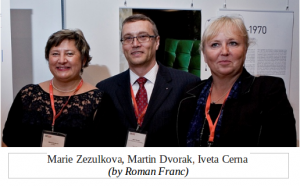
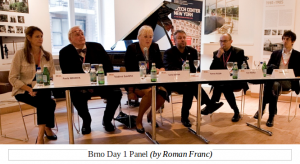
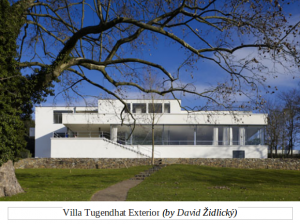
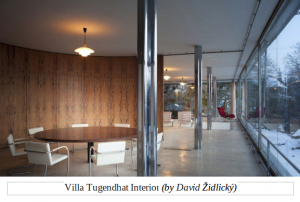
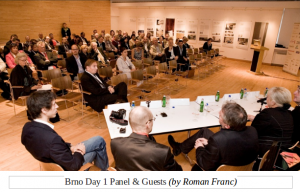
[...] Brno Days: Day 1 – Villa Tugendhat, Functionalism, Culture & History [...]